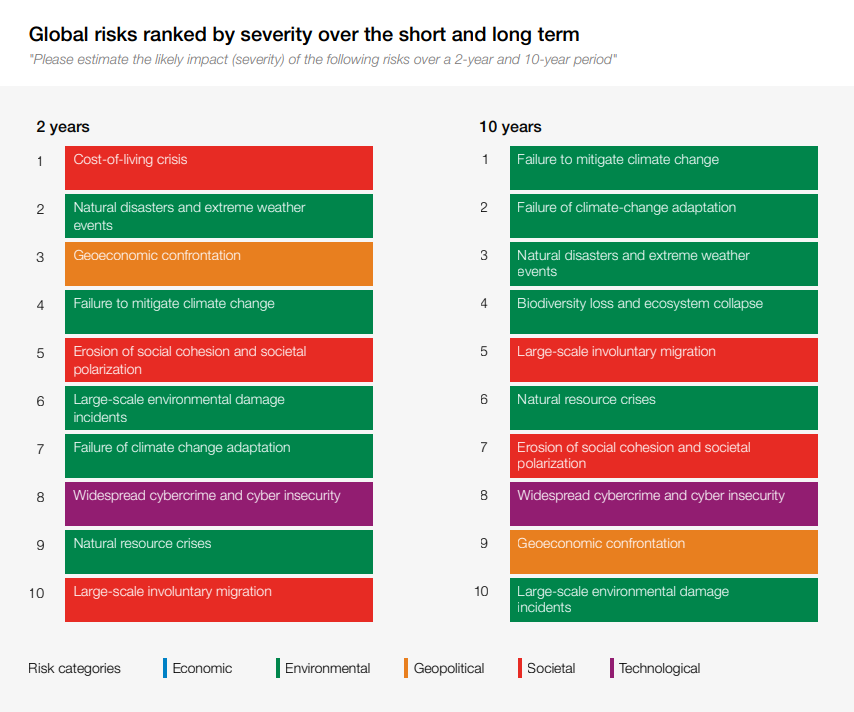Cyber Insecurity Ranks Eighth Place in WEF Global Risks Report 2023
Apr 25, '23 by Joerg Schneider-Simon
The world faces a set of risks that feel both wholly new and eerily familiar. The Global Risks Report 2023, published by the World Economic Forum (WEF), explores some of the most severe risks we face over the next decade.
As you can see from the table, “widespread cybercrime and cyber insecurity” ranks No. 8 of the top 10 risks described in the report. According to the WEF, “Technology will exacerbate inequalities while risks from cybersecurity will remain a constant concern.”

Cybercrime Remains in Top 10 Most Concerning Risk for Doing Business Globally
The Global Risks Report 2023 explores the most significant threats we may face in the years to come as we enter a period of low growth and lack of cooperation. Along with an increase in cybercrime, there is also the potential for malicious actors to disrupt critical technology-enabled services and resources. These include agriculture, water, financial systems, public security, transport, energy, and communication infrastructure. In addition, the misuse of personal data through legal channels will undermine digital sovereignty and the right to privacy, even in countries with strong regulations.
“Continued supply-side pressures risk turning the current cost-of-living crisis into a wider humanitarian crisis within the next two years in many import-dependent markets,” say the authors of the report. They conclude that, as public-sector funding continues to dwindle and security risks increase, our ability to withstand the next global crisis is weakening.
Over the next decade, fewer countries will have the financial resources to invest in growth, green technologies, education, health care, and other essential services. And while the gradual deterioration of public infrastructure and services in both advanced and developing markets may not be immediately apparent, its cumulative effects will be highly damaging to human capital and development, which are essential in mitigating other global risks.
According to the World Economic Forum's Global Cybersecurity Outlook report, cyberattacks have grown by an alarming 125% globally in 2021, and the trend is expected to continue. In light of this, it is essential for leaders to take a strategic approach to cyber risks. Leaders must ask themselves: what can be done to better prepare for future cyber shocks? What individual and collective actions can be taken to create a more secure and resilient digital ecosystem?
Your SAP Malware Challenge
Anti-virus software designed for enterprise use fails to safeguard SAP applications against malware. This is because SAP utilizes unique methods for handling files that are not monitored by standard malware-detection software. Specifically, the encryption and storage facilities employed by SAP are not integrated with traditional anti-virus programs.
The problem with detecting malware in SAP applications arises from the fact that they use proprietary network protocols (such as "DIAG" and "RFC") and a proprietary authentication and encryption method (known as SNC) to transfer files and communicate. As a result, standard network-level anti-virus software cannot detect files that are being transferred over these connections.
In addition, SAP applications store uploaded files in a distinct manner, utilizing SAP-proprietary data repositories, such as a database or a document management system (like the SAP content server) instead of the file system. This means that any malware-infected files are concealed within these silos, making them undetectable by anti-virus software when they are being stored.
The combined effect of these two shortcomings is that malware uploaded directly to SAP applications frequently evades detection. This poses a heightened risk of malware being spread to internal users, or even worse, to external users such as customers and suppliers.
Without adequate malware detection software protecting your SAP applications, third-party users could inadvertently download malware when accessing your SAP system. This could lead to significant damage to your company's reputation and potential legal liabilities for any harm caused by the malware infecting their system.
Are You Prepared?
At bowbridge, we believe that one step to protecting your organization against tomorrow’s “widespread cybercrime and cyber insecurity” is to conduct an SAP Cybersecurity Self-Assessment. This online tool helps you discover how prepared your organization is right now to withstand cyberattacks. Our helpful self-assessment helps you determine whether your SAP system is well-secured or a low-hanging fruit for attackers. Take the assessment now.


Share this on social: